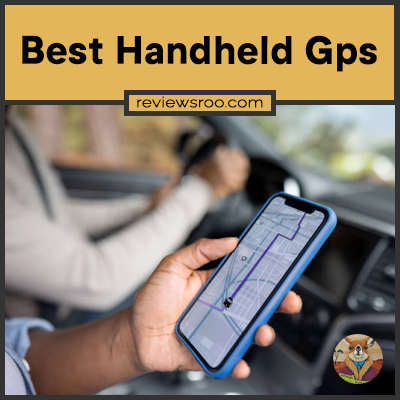Best Handheld Gps
GPS technology has revolutionized the way we explore and travel. According to a recent survey, nearly two-thirds of Americans now own a GPS device or smartphone with GPS capabilities. With so many options on the market, it can be difficult to know which type of GPS is best for you. This article will explore the top handheld GPS devices and help you find the right one for your needs.

In an increasingly digital world, having a reliable handheld GPS device is invaluable. Not only can they help guide you to your destination, they provide extra security in case of emergencies as well. Handheld GPS systems have come a long way in recent years and now offer features such as built-in weather tracking and more detailed maps than ever before.
Whether you’re an avid hiker, sailor or just looking for an affordable navigation system, this article will provide all the information you need to make the best decision for your needs. We’ll take a look at some of the most popular handheld GPS models on the market today and discuss their features and benefits. So read on to learn more about finding the perfect GPS device for you!
Top Pick: Garmin GPSMAP 64 Worldwide Smartwatch
The Garmin GPSMAP 64 Worldwide Smartwatch is a versatile and feature-rich device that combines advanced navigation capabilities with smartwatch functionality. With its reliable GPS tracking, rugged design, and extensive map coverage, it is an excellent choice for outdoor enthusiasts and adventurers seeking a reliable navigation companion.
Reliable GPS tracking: It utilizes a high-sensitivity GPS and GLONASS receiver, providing accurate and precise positioning even in challenging environments. Whether you’re hiking in remote areas or exploring unfamiliar territories, this smartwatch ensures you stay on the right track.
Rugged design: It is built to withstand the elements, with a durable construction that is water-resistant and shockproof. This makes it suitable for various outdoor activities, ensuring it can withstand rough conditions and last through your adventures.
Extensive map coverage: It comes preloaded with worldwide basemap and supports additional maps, including topographic maps, marine charts, and more. This allows you to explore and navigate various terrains with confidence, whether you’re on land or water.
Pros:
- Accurate GPS Tracking
- Rugged and Durable
- Extensive Map Coverage
Cons:
- Complex Interface
- Limited Smartwatch Features
Garmin Montana Handheld GPS
The Garmin Montana Handheld GPS is a powerful and rugged navigation device designed for outdoor enthusiasts and professionals. With its large touchscreen display, versatile mapping capabilities, and robust construction, it offers reliable navigation and mapping functionalities in even the most demanding environments.
Large touchscreen display: The 4-inch color display provides excellent visibility and allows for easy operation and navigation. Whether you’re viewing maps, inputting waypoints, or accessing various features, the touchscreen interface ensures a user-friendly experience.
Versatile mapping capabilities: It supports a wide range of maps, including topographic maps, marine charts, and BirdsEye Satellite Imagery. This allows you to customize your maps based on your specific needs and activities, whether you’re hiking, boating, or exploring off-road.
Built to withstand the rigors of outdoor use: It is rugged and durable, with an IPX7 water-resistance rating and a tough construction that can withstand bumps, shocks, and even immersion in water. This makes it a reliable companion for any outdoor adventure.
Pros:
- Large Touchscreen Display
- Versatile Mapping Capabilities
- Rugged and Durable Construction
Cons:
- Large and Bulky Size
- Limited Battery Life
Garmin eTrex Handheld GPS
The Garmin eTrex Handheld GPS is a compact and reliable navigation device designed for outdoor enthusiasts and hikers. With its intuitive interface, durable construction, and impressive battery life, it offers essential navigation features in a user-friendly package.
Compact size and lightweight design: It easily fits in your pocket or backpack, making it highly portable and convenient for outdoor adventures. Despite its small size, it doesn’t compromise on functionality and provides reliable navigation capabilities.
User-friendly interface: The intuitive menu system and simple controls make it easy to navigate through different features and functions. Whether you’re setting waypoints, tracking your route, or accessing maps, the eTrex ensures a straightforward and hassle-free user experience.
Impressive battery life: With up to 25 hours of continuous use on two AA batteries, it provides long-lasting performance during extended outdoor trips. This is particularly advantageous for hikers, backpackers, and outdoor enthusiasts who require reliable navigation for extended periods without access to charging.
Pros:
- Compact and Lightweight Design
- User-Friendly Interface
- Impressive Battery Life
Cons:
- Limited Display Size
- Basic Mapping Capabilities
Garmin inReach SE+ Handheld Satellite Communicator
The Garmin inReach SE+ is a versatile handheld satellite communicator that provides reliable communication and navigation capabilities, even in remote areas without cellular coverage. With its two-way messaging, GPS tracking, and SOS functionality, it offers peace of mind and connectivity for outdoor adventurers and travelers.
Global coverage through the Iridium satellite network: This means you can stay connected and send messages from anywhere on the planet, regardless of cellular reception. It provides a lifeline for communication and safety, allowing you to stay in touch with loved ones or request emergency assistance when needed.
GPS tracking capability: You can track and share your location with friends and family in real-time, giving them peace of mind about your whereabouts during your outdoor adventures. Additionally, the device allows you to plan routes, set waypoints, and navigate using the built-in GPS functionality.
Integrated SOS button for emergency situations: If you find yourself in a critical situation, pressing the SOS button will trigger a distress signal, and your coordinates will be transmitted to the GEOS 24/7 search and rescue monitoring center. This feature provides an essential lifeline in life-threatening emergencies.
Pros:
- Global Coverage and Two-Way Messaging
- GPS Tracking and Navigation
- SOS Functionality and Emergency Assistance
Cons:
- Subscription Required
- Limited Screen Size and Interface
Garmin Alpha 100 Handheld GPS Track and Train System
The Garmin Alpha 100 is a highly capable handheld GPS track and train system designed specifically for hunting and training dogs. It offers advanced GPS tracking features, precise navigation, and remote training functionality, making it an essential tool for hunters and dog enthusiasts.
Comprehensive dog tracking capabilities: The device allows you to track up to 20 dogs simultaneously, providing real-time location updates, distance traveled, and speed. This feature enables you to keep a close eye on your dogs and ensure their safety during hunting or training sessions.
Remote training functionality: With the compatible Garmin T5 or TT15 dog collar devices, you can remotely send training signals to your dogs, including tone, vibration, or stimulation, helping you reinforce commands and control their behavior. This capability enhances training efficiency and facilitates effective communication between you and your dogs.
Precise navigation features to support your hunting expeditions: It includes detailed topographic maps, preloaded with TOPO Australia and New Zealand, which provide valuable information about terrain, land boundaries, and points of interest. The handheld device also features a compass, barometric altimeter, and multiple waypoint and track management tools to assist you in navigating challenging environments.
Pros:
- Advanced Dog Tracking
- Remote Training Capability
- Precise Navigation and Mapping
Cons:
- Cost
- Learning Curve
Overview Of The Best Handheld Gps
Ah, the days of getting lost! Who doesn’t miss them? Well, if you do, you’re in luck. With today’s technology, you can get a handheld GPS unit that will help you find your way back home. Let’s take a look at some of the best handheld GPS units on the market and their benefits.
First off, Garmin’s eTrex is an excellent choice for outdoor activities such as hiking, camping, and geocaching. It’s small size makes it easy to carry around and its bright LCD display makes it easy to read in any lighting conditions. The unit also comes with a built-in compass and altimeter, allowing users to easily track their progress in unfamiliar terrain. Additionally, Garmin offers support for all types of GPS maps – from topographical maps to marine charts – ensuring that this device has something for everyone.
For those who need something more robust than the eTrex but don’t want to break the bank, Magellan’s Triton Series is a great option. This series features touchscreen displays that are quick and intuitive to use. You can also store up to 10 tracks or routes on this device so you’ll never have to worry about losing your way again. What’s more, it has an IPX 7 water resistance rating so you don’t have to worry about using it in wet conditions either!
These are just two examples of quality handheld GPS units available today; there are many others out there as well. Whichever one you choose though, you can be sure that having one will help make your next adventure less stressful and much more enjoyable! Transitioning into the next section without saying ‘step’, we’ll discuss the benefits of having a handheld GPS unit even further.
Benefits Of A Handheld Gps
It’s like running a marathon: You can’t do it without the right gear. A handheld GPS is that essential tool when navigating the wilds of life. Its importance cannot be understated.
The benefits of a handheld GPS are manifold. From tracking your progress to optimizing your route, having a reliable device can make all the difference. It’s not just about navigation either; modern GPS devices come with useful features like tracking speed and altitude, or connecting to other devices for more detailed data results. Plus, you don’t have to worry about getting lost in unknown terrain! With a handheld GPS, you’ll always know where you are and how far you’ve come.
No matter where you’re going, having a good handheld GPS will help make sure you get there safely and quickly – no wrong turns necessary!
Features To Look For In A Handheld Gps
When looking for the best handheld GPS, it’s important to consider the features that will make your device truly stand out. Just like a carpenter needs the right tools to build a house, you need the right features to make your navigation experience successful.
Take, for example, an ultralight backpacker who needs to navigate around an unfamiliar city. He needs a handheld GPS with long battery life, strong satellite reception and detailed maps of his destination. Not only do these features help him find his way around quickly and easily, but they also give him peace of mind in knowing that he won’t get lost along the way.
For hikers and hunters, features such as water resistance are essential for navigating rough terrain. An altimeter is another helpful feature for those looking to accurately measure their elevation during hikes or climbs. For anyone who likes to be on the go, a rugged design is key for protecting against wear and tear from frequent outdoor use.
No matter what type of outdoor explorer you are, there’s a handheld GPS out there that can fit your needs perfectly. With a little research into the available features on various models, you’ll soon have the perfect companion for all your adventures!
How To Choose A Handheld Gps
When it comes to picking a handheld GPS, you want to be sure you’re getting the best bang for your buck. With so many options on the market, it can seem like a daunting task. But don’t worry, with a few pointers in mind, you’ll be navigating the great outdoors in no time.
First things first, consider your budget and lifestyle. Will you be using it for short hikes or long-distance backpacking trips? Knowing what kind of terrain and conditions you’ll be facing will help narrow down the available models. Look for features like waterproofing, multi-satellite support, and battery life that meet your needs. It’s also important to make sure any model you choose is lightweight and easy to use with multiple navigation systems built-in.
Once you’ve identified the features that are most important to you, check out reviews from other users who have tested different models in similar environments. This should give you enough information to make an informed decision about which one is right for you. With a little bit of research beforehand and careful consideration of your needs afterwards, choosing that perfect handheld GPS won’t be so hard after all.
Popular Brands Of Handheld Gps
Finding the right handheld GPS can be tough. But, once you’re decided on a brand, it’s time to start shopping. Popular brands of handheld GPS include Garmin, Magellan, and DeLorme. All three offer solid products that are reliable and accurate.
Garmin is one of the most well-known makers of handheld GPS units. Its lineup includes high-end models that offer features like voice recognition and detailed maps of roads and trails around the world. Magellan has a range of durable devices that are designed for outdoor use, while DeLorme makes some budget-friendly models with simpler interfaces.
No matter which brand you choose, you’ll want to make sure it meets your needs. Consider things like battery life, display size, navigation features, and software compatibility before making a decision. With the right model in hand—literally—you can confidently explore outdoor locations with ease.
Benefits Of A Smartphone App For Handheld Gps
Handheld GPS devices are great for navigating outdoors. But with the advent of smartphone technology, there are now apps that make using a handheld GPS even more convenient. Here are some benefits of having a smartphone app for your handheld GPS:
- Real-time updates on location and route.
- Ability to download maps and data to use offline.
- Access to additional features like weather and elevation information.
- Easily share your location with others in real-time.
- Compatible with most existing handheld GPS devices.
These benefits make smartphone apps an ideal addition to any handheld GPS device, allowing users to stay up-to-date on route changes, access additional information, and share their location easily with friends or family members. With all these advantages, it’s no surprise that more people are choosing to use a smartphone app alongside their handheld GPS device. Moving on…
Comparison Of Handheld Gps Prices
Navigating the world of handheld GPS prices can be a murky affair. But with a bit of knowledge, you can find yourself in the driver’s seat.
There are several factors to consider when comparing GPS prices, such as features and brand. Some brands offer more features than others, but the price points vary greatly. It’s important to take into account your own needs and budget before making a purchase. Different models have different advantages and disadvantages that should be weighed against one another when making a comparison.
It pays to do some research as well; many websites offer comparison tools and reviews from other users who have tried out particular models. This way you can get an idea of what would work best for you without spending too much money or ending up with an unsuitable device.
Tips For Using Handheld Gps
Using a handheld GPS can be an invaluable tool for navigating the world. But there are some essential tips to keep in mind when using one. Here are three key points:
- Know Your Device: Before heading out, get familiar with how your GPS works. This will save time and minimize frustration.
- Stay Updated: Make sure your software is up-to-date. Download updates and check the maps regularly to make sure you have the most accurate information available.
- Power Management: Keep an eye on the battery life, especially if you’re out in remote areas with no access to a power source. Bring extra batteries or a power bank just in case.
These tips should help make using a handheld GPS easier and more efficient. Knowing your device, staying updated, and managing power can help ensure successful navigation. With this knowledge, users can feel confident taking their device into any environment and relying on it for direction.
Issues To Consider When Using Handheld Gps
Using a handheld GPS can be a great way to navigate, but there are some important issues to consider. First, you need to make sure that you have the correct version of the map on your device. If the maps are out of date, they might not include recent changes in roadways or terrain. You also want to be aware of any restrictions or regulations that apply when using GPS devices in certain areas.
You’ll also want to pay attention to battery life and extra features like geocaching or real-time tracking. Keeping a spare set of batteries is always a good idea, as well as researching how long each charge will last based on how you plan to use it. Knowing what features your device offers can help you get the most out of it while navigating unfamiliar terrain. And next up is caring for your handheld GPS properly.
How To Properly Care For Handheld Gps
Caring for your handheld GPS is like taking care of a newborn baby – it deserves all the tender loving care you can give. This device has become an invaluable tool for navigating the world, and with proper maintenance, it can last a lifetime!
The first step in caring for your handheld GPS is to keep it clean. Dust and dirt can collect on its surface, so make sure to wipe it down regularly with a damp cloth. Additionally, if you take your GPS outdoors, be sure to keep it dry and away from excess moisture. You should also avoid exposing your device to extreme temperatures – too hot or too cold – as this could damage its internal components.
When not in use, store your GPS in a safe place where it won’t get scratched or bumped around. If possible, store it in the original case that came with the device. Finally, make sure to update the software regularly so that your device remains up-to-date with the latest features and bug fixes. With these simple tips and tricks, you can ensure that your handheld GPS will remain in perfect condition for years to come!
Frequently Asked Questions
What Type Of Battery Does A Handheld Gps Use?
The battery of a handheld GPS is like a gift from the heavens, bringing the traveler a sense of security and assurance. Delivering them to their destination with ease and accuracy, it’s no wonder why these devices are so popular for hikers and explorers alike.
But what kind of power source does this miracle worker carry? Many models use two AA batteries, providing around 16 hours of life when fully charged. Depending on your device and usage, you may find lithium-ion or nickel-metal hydride rechargeable batteries preferable for their increased longevity. You’ll want to check your model’s specifications for exact battery requirements before purchasing replacements.
Whether traveling through unfamiliar terrain or just taking a scenic route, having a reliable source of power can take some stress off the journey. With the right type and number of batteries in hand, you can be sure that your handheld GPS will get you there without worry.
How Long Does The Battery Last On A Handheld Gps?
A handheld GPS offers convenience and portability. But they need a dependable battery to be useful. How long does the battery last?
It depends. Most handheld GPS devices are powered by AA or AAA batteries, which typically last anywhere from 8-12 hours. Rechargeable batteries can offer longer usage time, up to 24 hours. If you’re planning a long trip, it’s important to have multiple spare batteries or a car charger ready. Knowing your device’s energy consumption rate is key to getting the most out of your battery life; make sure to check the specifications of your device before you go out.
Ultimately, having the right equipment and understanding how to use it is essential for staying on track when using a handheld GPS device. It’s a good idea to plan ahead and prepare for any eventuality so you don’t get stuck in a bad situation with no power.
How Do I Update The Software On My Handheld Gps?
Updating the software on a handheld GPS can be a complex process. It’s important to know what steps to take and how to complete them. Here’s a 3-step guide:
- Download the most recent version of the GPS software from the manufacturer’s website. This will ensure you get the latest features and bug fixes.
- Connect your GPS device to your computer using the USB cable that came with it. The computer should recognize it as an external storage device, allowing you to transfer files between it and your computer.
- Transfer the new software file from your computer onto your GPS device, then disconnect it from your computer and turn it off before turning it back on again. This will launch the new software on your device and finish the update process.
Before updating, make sure you have all the necessary cables, drivers, and other materials needed for completing the process correctly. If in doubt, check with customer support or refer to any included documentation that came with your device.
What Is The Difference Between A Handheld Gps And A Smartphone App?
The debate over handheld GPS systems and smartphone apps for navigation is hotter than ever. With so many options available, it can be a daunting task to figure out what the differences are between them.
Navigating with a handheld GPS unit provides users with an accurate and reliable way to get from point A to point B. They are designed with features like back-lit screens, preloaded maps of an area, and highly sensitive receivers that make them ideal for more extreme activities such as hiking or off-road trips. On the other hand, smartphone apps usually require a data connection and offer fewer options when it comes to customization and accuracy.
The choice really depends on how much you plan on using the device in question: if you’re just looking for basic navigation while at home or in town, then a smartphone app might be all you need; but if you’re venturing out into more remote areas or doing something that requires extreme precision, then a handheld GPS system is the way to go. Ultimately, it’s up to you – both have their pros and cons – so take some time to think about your particular needs before making a decision.
Is A Handheld Gps Waterproof?
A handheld GPS can be like a life raft in unfamiliar waters. When you’re out in the wild, discovering uncharted territory, it’s important to have an anchor to keep you afloat. But is a handheld GPS really waterproof?
The answer is yes and no. While many handheld GPS units are made with waterproof materials, they aren’t fully submersible. That means that if a unit gets wet from rain or splashing, it will usually still work as normal – but if you dive too deep into the depths of a lake or ocean, then your device may suffer some water damage. So if you plan on taking your handheld GPS into extreme environments, it’s best to choose one that has been designed for such use and take the necessary precautions to protect your device from water damage.
Conclusion
I’ve explored the ins and outs of handheld GPS devices, so now I can make an informed decision on which one is right for me.
A handheld GPS device offers plenty of power and convenience. It runs on a rechargeable battery that lasts as long as I need it to without needing a charge. Plus, I can update the software with just a few clicks, ensuring that my device is always up-to-date.
The main difference between a handheld GPS and a smartphone app is the accuracy – the GPS will provide more precise directions than an app ever could. And since many come with waterproofing features, I don’t have to worry about getting caught in the rain!
So if you’re looking for something dependable and reliable that won’t let you down when you need it most, a handheld GPS might be just what you need. No matter where my journey takes me, this trusty device will be there to guide me home.










